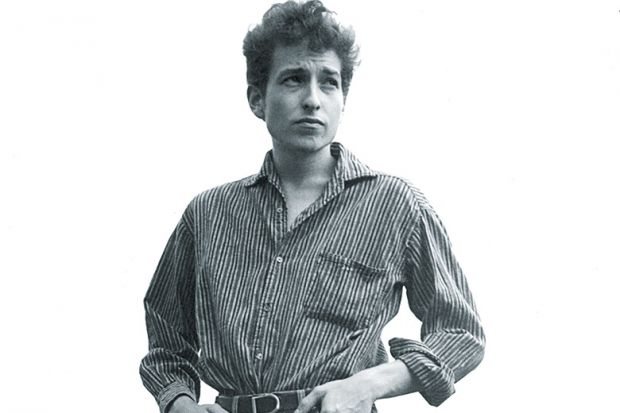Mavis Staples is a black gospel and rhythm and blues singer and long-time civil-rights activist. Bob Dylan sought her hand in marriage in 1962 and she is still touring with him today. When asked about what grabbed and shook her when she first heard his song that became a civil-rights anthem, Blowin’ in the Wind, she once explained: “We just wondered how with him being a little white boy, how could he feel all those things we felt, you know? All this pain and the hurt, you know. How could he write these songs? He saw things and he wrote about them.”
She felt something we can trace in Dylan’s music through 60 years of official and unofficial recordings, something palpable in the songs he sings and how he sings them – like Frank Sinatra, his way. Whether singing his own songs or songs by contemporaries, such as Warren Zevon, Gordon Lightfoot, Van Morrison or Willie Nelson, or those of songsters in two centuries of English-language popular traditions like Wade in the Water, Delia, Dark as a Dungeon, Hard Times, Jim Jones or Why Try to Change Me Now?, Dylan explores and conveys the workings of our human hearts.
Bob Dylan matters because he is doing now what he was doing in 1960 to 1962, when he was transfusing into his own being the restless, tragic life and poetic art of Woody Guthrie, who cared deeply for the poor and dispossessed and sang out about them and the people of wealth and power who robbed them with fountain pens and killed them in Ludlow, Colorado or Los Gatos Canyon.
Dylan told Guthrie, already long institutionalised and severely debilitated with Huntington’s disease, in Song for Woody (written probably in February 1961) that he was “seein’ your world of places and things/your paupers and peasants and princes and kings”. Dylan has always seen people and wondered feelingly about them – and himself. In Rolling Stone magazine’s number one rock’n’roll song of all time, Like a Rolling Stone, Dylan asks again and again, “How does it feel? How does it feel?”
Dylan sees people, places and things as an outsider and explores them as an insider. He envisions his subjects in the sound and word equivalents of the forms and colours of the painter that he is. He tells us that he learned in spring 1974 from artist Norman Raeben how to write songs “more like a painter would paint a song as [opposed] to compose it”. Like Wilfred Owen writing A Terre, Dylan has written haunting photographic song poems, too: Blind Willie McTell and Man in the Long Black Coat.
When Dylan writes and sings about the stuff of human lives, his words and images can be brutally direct, magically and mysteriously symbolic, tip-of-the-tongue allusive, intensely probing. He can be playful and joyous. We ride with him in the saddle on his big white goose (Country Pie). He sings us a nursery rhyme (Under the Red Sky). Besides painting, Dylan has used folk and blues songs, Tin Pan Alley rhymes and a deep love of movies to figure out how to put songs together so that they have a sustained emotional afterglow that linear narrative or straightforward reporting of what happened, where, when, why and how would not give them. Dylan has always known, like the ancient Greeks, that what is not true can be truer than true.
There it is. Simple. Only it isn’t.
Dylan’s songs can be placed into more categories than Argus has eyes. None of his songs lies etherised upon a table inviting us to dissect and interpret it.
Nonetheless, in Why Dylan Matters, Harvard University classicist Richard Thomas, a scholar of Virgil and a leading theorist and practitioner of intertextuality in Latin poetry, analyses the forms and contents of Dylan’s songs and takes us inside Dylan’s poetic artistry. Thomas is a “professor” in the best sense. He has real intellectual sympathies for Dylan, who is what the ancient Greeks called a “prophētēs”, a “prophet”, literally one who speaks forth what we would call true and false things. The Greeks lumped our true and false together in their peculiar word for “truth”. For them, truth meant what is unforgettable and must not escape our notice.
As an expert in what he calls the “best of Roman literature” from the 3rd century BC to the 2nd AD, Thomas’ work on Dylan complements Sir Christopher Ricks’ Dylan’s Visions of Sin (2004), which examined Dylan’s songs along with “the greatest English literature of the last five centuries”. Both Ricks and Thomas understand Dylan’s “love and theft” of other musical and literary works. Thomas here explains Dylan’s appropriations of passages from Homer’s Odyssey, Virgil’s Aeneid, Ovid’s Epistles from Pontus, Catullus’ love poems and Junichi Saga’s Confessions of a Yakuza as a distinctive practice of those T. S. Eliot calls good or mature poets. They “will usually borrow from authors remote in time, or alien in language, or diverse in interest” and they will “[weld their] theft into a whole of feeling which is unique”.
Thomas stresses that “for Dylan, it is the art of the song that matters”. Indeed, Dylan tells us in his Chronicles: Volume One (2004) that early on he noticed other singers trying to put themselves across, but he always “puts the song across”.
Thomas’ literary critical observations on Dylan’s art help us to see the Virgilian craft and hard labour that go into Dylan’s making of song poems. But Thomas also gives us his heartfelt personal take on what Dylan has meant to him from the age of 23 when he travelled from New Zealand to graduate school in the US – in his trunk were The Songs of Leonard Cohen (1967) and Dylan’s Blonde on Blonde (1966) – through to his teaching at Harvard four times over the past 13 years a freshman seminar on Bob Dylan.
Thomas offers insights into how particular songs work and how they are related to other songs and poems, even those without clear classical antecedents, eg, Fourth Time Around and the Beatles’ Norwegian Wood; or Rimbaud’s The Drunken Boat, as translated into English in the year after Dylan was born, and Dylan’s Mr. Tambourine Man. Thomas shows us in detail how Dylan’s Trying to Get to Heaven steals from blues and folk songs sung by the likes of Furry Lewis, Tom Rush and Woody Guthrie and collected by Alan Lomax and Byron Arnold.
As a harbinger of what future scholars are likely to discover in the Bob Dylan Archives in Tulsa, Oklahoma, Thomas pieces together from what Dylan wrote in a small blue spiral notebook of 45 pages the evolution of his signature masterpiece Tangled up in Blue (1975). The song started out being called “Dusty Sweatbox Blues” and then probably “Blue Carnation”.
In closing, Thomas comments on Dylan’s words to the Swedish Academy concerning his Nobel Prize in Literature. Two statements stand out: “It’s my songs that are at the vital center of almost everything I do”; and “Some songs – Blind Willie [McTell], The Ballad of Hollis Brown, Joey, A Hard Rain, Hurricane, and some others – definitely are Homeric in value. The academics, they ought to know.”
Richard Thomas proves that some of us actually do.
Tom Palaima is professor of Classics, University of Texas at Austin.
Why Dylan Matters
By Richard F. Thomas
William Collins, 368pp, £12.99
ISBN 9780008245498
Publication 16 November 2017

The author
Richard F. Thomas, George Martin Lane professor of the Classics at Harvard University, spent his early life in New Zealand and recalls “sailing, swimming in the ocean, diving off ferry wharves, climbing cliffs, taking risks of which my parents, like all parents of that earlier age, were oblivious, and generally learning to be disobedient…Growing up in such a beautiful setting, in a country that has always seemed to value social and economic justice, in a time that seemed more simple than it probably was, has always stayed with me.”
As an undergraduate at the University of Auckland, Thomas starting out doing Classics and law, “moving on to Classics and Japanese after hitting land law”, and then settling for just Classics, in which he went on to a doctorate at the University of Michigan. Although a Bob Dylan fan from about the age of 14, “[the] 1960s and 1970s singer-songwriters were not of academic interest until graduate school, when I started thinking about similarities of outlook between his lyrics and the Greek and Roman lyric poets, Sappho and Catullus for instance”. The approach has gained added relevance since 2001, “when the poetry of Homer, Virgil and Ovid became part of Dylan’s songwriting. Particularly in recent years, Dylan has taken on the age-old practice of intertextually activated composition…with such success that his versions are equal or superior to the stolen contexts.”
Asked about the continuing relevance of the Classics, Thomas stresses the value of “any song or literature that has survived precisely because it has been found time and time again to help human beings live examined lives that are worth living…The vocational value of the humanities in teaching critical and analytic thinking, for which there is now anecdotal as well as empirical evidence, tends to get downplayed in the rush to expand the reach of STEM. People have been talking about the death of the Classics for the last two centuries, but we’re still here.”
Matthew Reisz
POSTSCRIPT:
Print headline: For love, for art, he took from them everything he could steal
Register to continue
Why register?
- Registration is free and only takes a moment
- Once registered, you can read 3 articles a month
- Sign up for our newsletter
Subscribe
Or subscribe for unlimited access to:
- Unlimited access to news, views, insights & reviews
- Digital editions
- Digital access to THE’s university and college rankings analysis
Already registered or a current subscriber?









